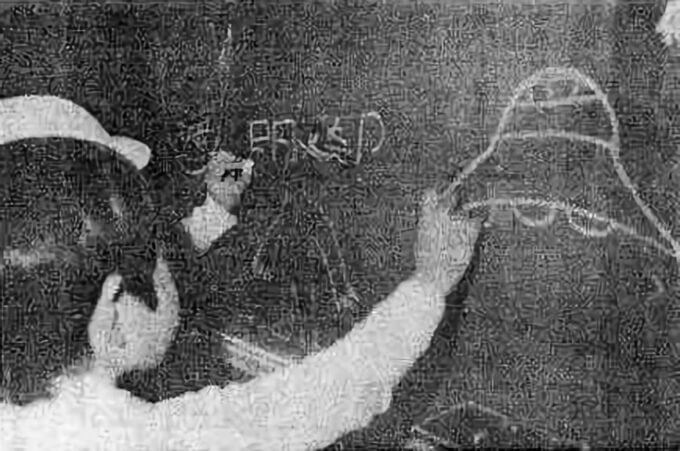
This is a true story of a creepy alien who got off a UFO to a vineyard and tapped a Japanese boy on the shoulder in 1975.
In the articles below, I introduced the Kofu Incident, one of the two major UFO incidents in Japan along with the Kera Incident, i.e., the bizarre incident that occurred in 1975 when two Japanese boys contacted aliens who landed on a vineyard from a UFO.
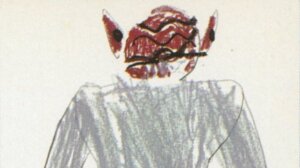
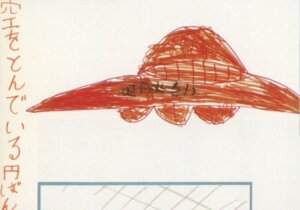
Surprisingly, the many reports of UFO/alien sightings in Kofu City on the same day make it clear that the Kofu Incident was not the result of the two boys’ delusions or fabrications, but that “something actually happened”.
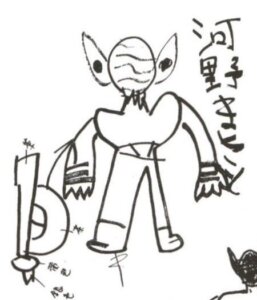
Of course, all of the above reports are often taken up by Japanese UFO-positive groups and may be biased. In fact, it should be noted that the articles and videos on the Kofu Incident that have been circulating outside of Japan are biased, as they are all based on information from Japanese UFO-positive groups.
However, I will try to be as objective and fair as possible in presenting not only the positive information but also the negative information in as much detail as possible.
In this article, I would like to present the negative view of the Kofu Incident by Japanese UFO skeptics and the latest information about the Kofu Incident as of March 2023.
Negative Views and Updates on the Kofu Incident
Ichiro Minegishi, Third Boy to Witness a UFO
In the Kofu Incident, the names of two boys, Masato and Katsuhiro, are widely known as witnesses to UFOs and aliens. However, it is not widely known that in addition to the two boys, there was a third boy who witnessed a UFO on the same day. According to the first report in the Yamanashi Nichinichi Shimbun, which introduced the Kofu Incident, there was another student from Yamashiro Elementary School who witnessed a UFO on the same day, in addition to Masato and Katsuhiro.
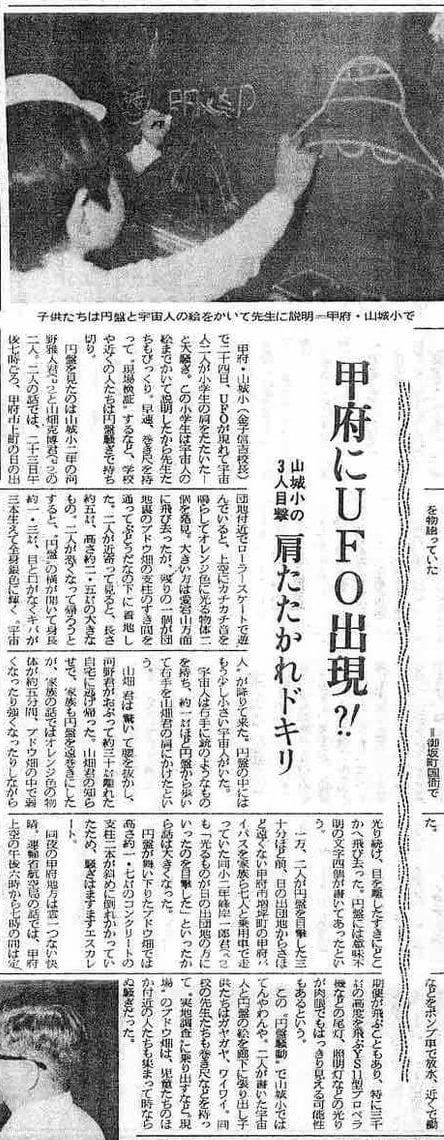
The headline read, “UFOs Appear in Kofu?! Three students at Yamashiro Elementary School witnessed them. (One of the students was) tapped on the shoulder (by an alien), which made him startled.”
This third witness is Ichiro Minegishi (age 8), who was a second-grade boy at Yamashiro Elementary School, just like Masato and Katsuhiro. Ichiro reported that about 30 minutes before Masato and Katsuhiro witnessed the UFO while driving with seven others including his family on the Kofu Bypass (National Route 20) in Masutsubo-cho, Kofu City, not far from the Hinode Complex, Ichiro saw a mysterious light object from inside the car.
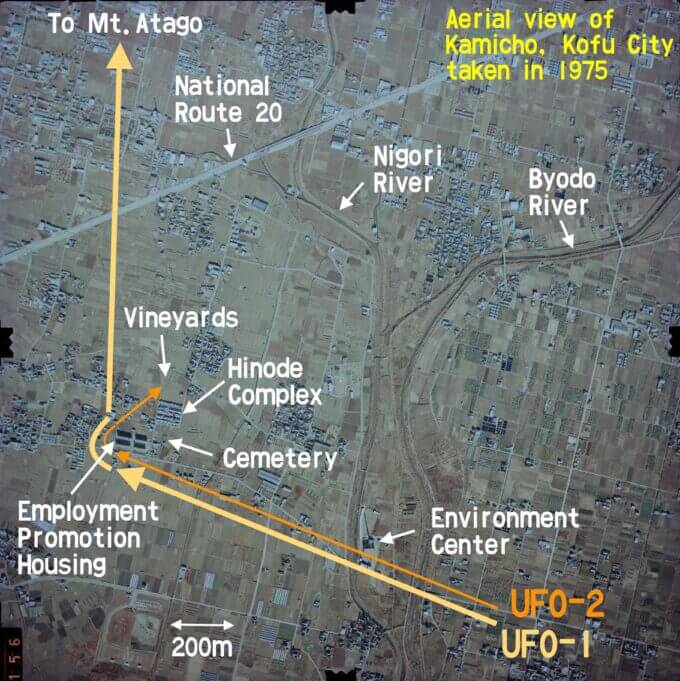
According to the report, he witnessed a glowing object flying toward the Hinode Complex, and this report supported Masato and Katsuhiro’s UFO sighting, which led to a great buzz about the Kofu Incident.
In addition, according to “Intruders from Outer Space” by Japanese writer and paranormal researcher Hiroshi Minamiyama, Ichiro saw a blue-white luminous object moving back and forth across the night sky in the direction of the Kami Town complex from his car on National Route 20 (Kofu Bypass), about 1 km north of the UFO landing site.
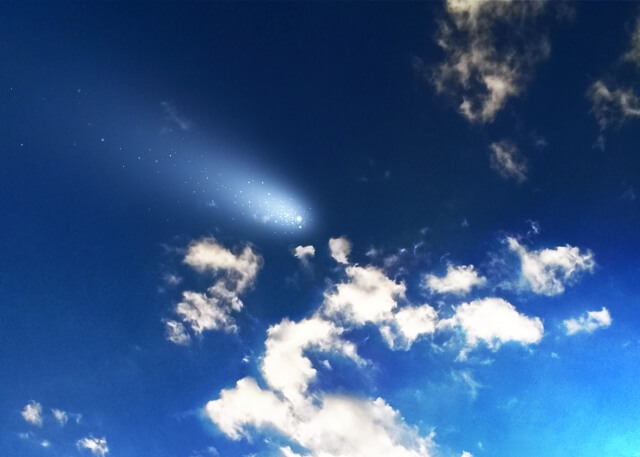
Furthermore, reporters from the local Yamanashi Nichinichi Shimbun newspaper interviewed residents in the area on the night of the incident and found several other UFO sightings.
One of those sighting reports came from Atsushiba, the janitor of an environmental center located about 800 meters east-southeast of the Hinode complex. According to Atsushiba, at around 6:30 p.m., he saw a flashing luminous object glide across the western sky and slowly move toward the north.
Regarding this luminous object, Tatsuya Honjo, president of ASIOS (Association for Skeptical Investigation of Supernatural), pointed out that the luminous object might be an airplane light. According to him, when the airplane flies toward the witness, the lights appear to stop in the air, and then, if the airplane changes direction during the flight, the lights suddenly appear to move.
In fact, the Yamanashi Nichinichi Shimbun article above states that according to the Ministry of Transport’s Civil Aviation Bureau, there are scheduled flights over Kofu between 18:00 and 19:00, and in particular, the tail lights of YS-11 propeller planes flying at an altitude of 3,000 meters may be clearly visible to the naked eye.
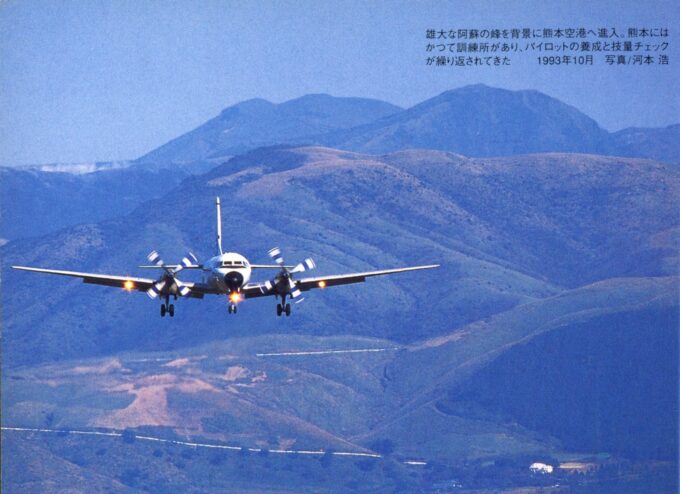
In addition, Genshin Saito, the head priest of Jokoji Temple, said he witnessed a blue-white luminous object about the size of a ping-pong ball flying zig-zag in the sky south of the temple, then swooping down and disappearing.
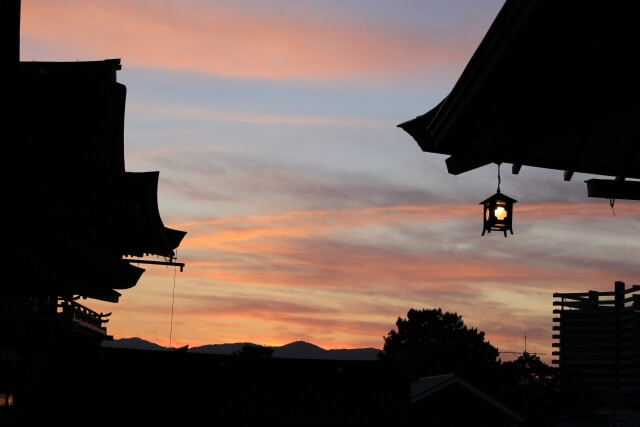
Regarding this luminous object, Honjo introduces the comment of Ken Sato, who was a member of the satellite observation team at Hiroshima University, in the August 1975 issue of “UFO and Space” magazine published by Cozmo publishing. According to his comment, Sato presented an example of a satellite that should be flying straight but appears to be zigzag due to an optical illusion and said that “even an object moving in a straight line can appear to stagger to the human eye.
Honjo, therefore, points out that, given the fact that the skies over Kofu City are the route of the YS-11, the possibility that the Jokoji temple head priest’s UFO sighting was also a misidentification of aircraft lights cannot be dismissed.
Honjo’s theory that the luminous object seen by several people on the night of the Kofu Incident was a misidentified YS-11 aviation light seems plausible. So, let’s examine the validity of this Honjo’s theory from various angles.
As I mentioned above, both Ichiro Minegishi and the head priest of Jokoji Temple witnessed a blue-white luminous object.
By the way, Article 64 of Japan’s Civil Aeronautics Law (Law No. 231 of 1952) contains provisions regarding aircraft lights and strictly stipulates that aircraft operating at night shall use lights of the colors specified by the said enforcement regulations for lights equipped in accordance with Article 154 of the Civil Aeronautics Law Enforcement Regulations (1952, Ministry of Transport Ordinance No. 56).
According to the provisions of the Enforcement Regulations of the Civil Aeronautics Law, red aviation lights shall be located on the leading edge of the left wingtip, green aviation lights shall be located on the leading edge of the right wingtip, and white aviation lights shall be on the tail or wingtip as far aft as possible. It further stipulates that aircraft shall be provided with powerful flashing lights to avoid collisions and that the anti-collision lights shall be flashing lights located at the top and bottom of the fuselage, at the wingtips, and at the tail of the aircraft.

Source: Tosaka – Made by uploader(ref:日本航空技術協会編、『航空電気入門』、社団法人日本航空技術協会、2002年3月12日第1版第4刷発行、ISBN 4930858844)
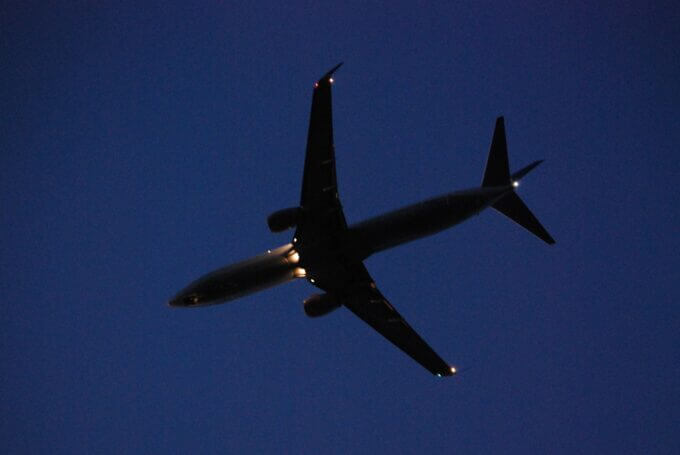
In the photo below, in addition to the three landing lights on the YS-11, red and green aviation lights can be seen on the leading edges of the left and right-wing tips, respectively.
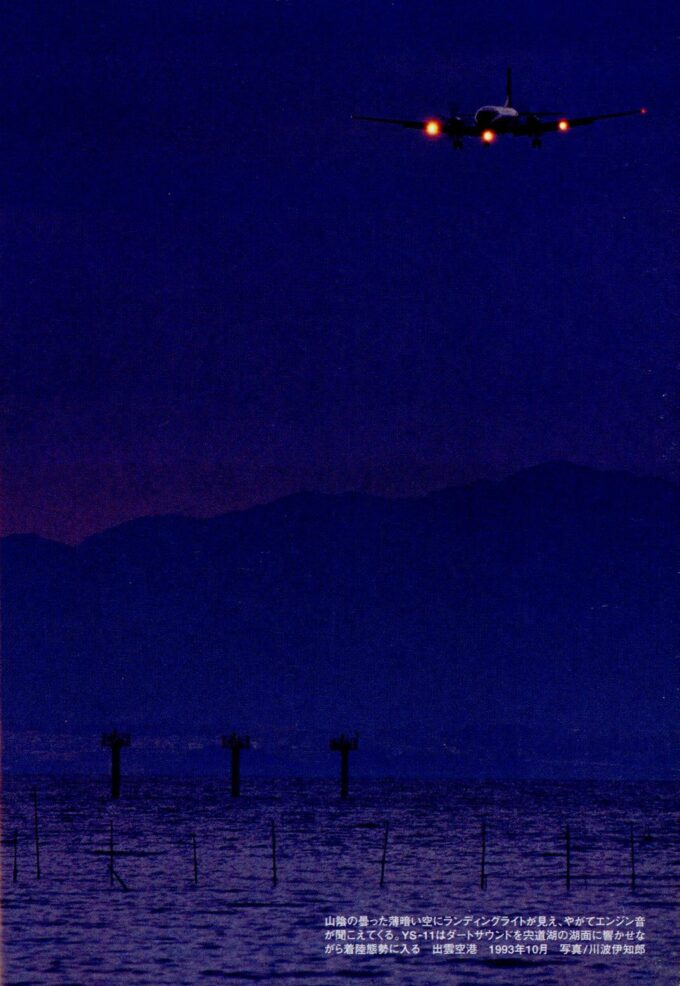
From this, it would be conceivable that the white aviation light on the tail of a YS-11 flying at night could have appeared to be a blue-white luminous object.
Next, let’s examine the YS-11’s route at that time.
I researched YS-11 routes and obtained a detailed YS-11 route map from 1976.
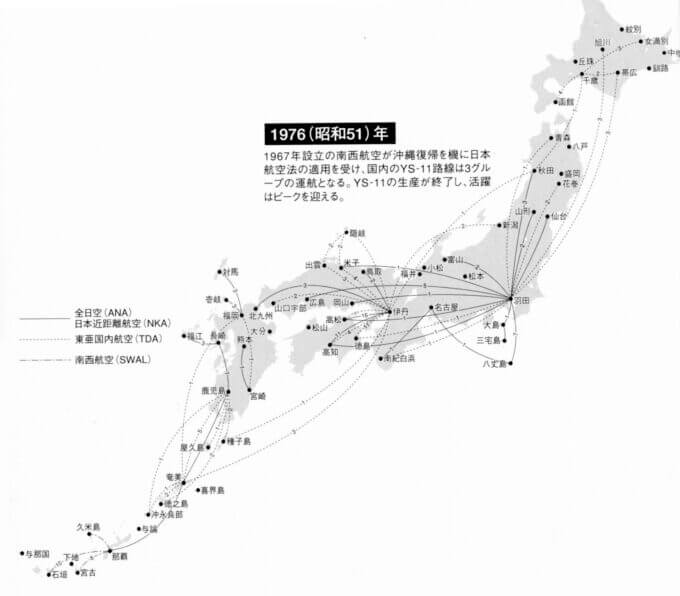
And I found that an All Nippon Airways (ANA) Nippon Kinkyori Airlines (NKA) flight from Haneda to Okayama passed just over Kofu City, as shown in the figure below.
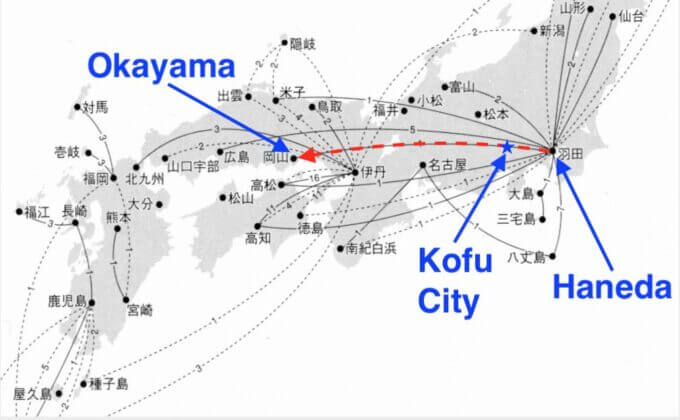
As long as the YS-11 was on this east-to-west course, it is highly unlikely that the luminous object moving westward would suddenly change its course to the north, as Atsushiba’s eyewitness account described.
In addition, Jokoji Temple is located at the northern foot of the Misaka Mountains a few kilometers south of the Kamimachi housing complex, far to the south of the YS-11’s route from Haneda Airport. Therefore, it is conceivable that the blue-white luminous object that the head priest of Jokoji Temple saw to the south could have been the aviation light of a YS-11 on the other route from Haneda to Takamatsu in Shikoku.
But if that were the case, it would be inconsistent with the above sightings of luminous objects from Route 20 and the Environmental Center.
Thus, in light of the actual routes of the YS-11, various inconsistencies arise in the theory that the blue-white luminous object in question was caused by a misidentification of the YS-11’s aeronautical lights.
Possibility of Meteor
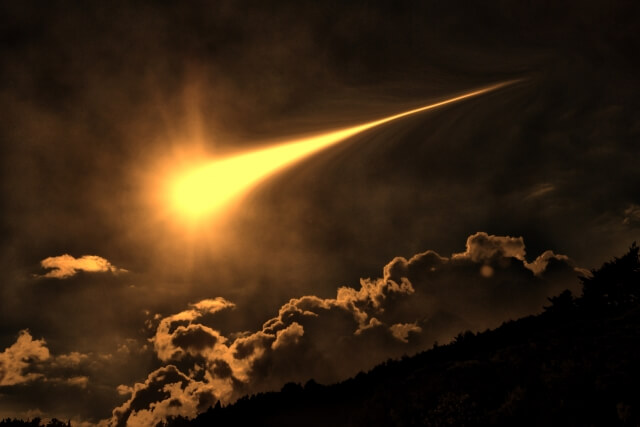
By the way, a UFO was sighted in Kofu City before 1975.
Tamio Kageyama (1947-1998), a Japanese novelist and TV writer, witnessed a UFO when he was in the sixth grade of an elementary school in Kofu City due to his father’s job transfer. According to him, this was a famous incident that was reported in newspapers at the time.
If this is true, then it would seem that Kofu City has long been an area where mysterious luminous objects have appeared.
Here, Atsushiba, the manager of the environmental center, says that he witnessed a yellow luminous object with a tail in the eastern sky at around 6:30 PM on the day of the incident and that a person at the municipal office also saw the same object and said that it was “probably a meteor.
Could it be possible, then, that a meteor was misidentified as a UFO?
According to the Nippon Meteorological Society’s database of bolides (a bolide is an exceptionally bright meteor), there have been a total of 192 reported sightings of bolides in Yamanashi Prefecture over the 40 years since 1984.
http://www5e.biglobe.ne.jp/~shibaya/NMS/database.htm
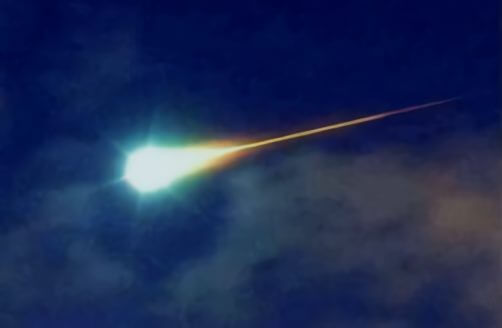
Source: Boliden-Phasen.jpg: Thomas Grau derivative work: Basilicofresco (msg) – Boliden-Phasen.jpg
An interesting case of bolides sighted in Yamanashi Prefecture is the Makioka bolide that appeared over Yamanashi Prefecture from southern Nagano Prefecture at 04:05 JST on March 2, 2008, with a record of a meteorite falling on Makioka-cho ( present-day Koshu City).
According to Masayoshi Ueda’s orbit calculation, an orbit similar to that of an asteroid approaching a general earth orbit was obtained.
Also, on November 12, 2019, at 22:00:23 JST, a bright bolide (Tateshina bolide) appeared in a northwesterly direction from northern Yamanashi Prefecture to over Chino City, Nagano Prefecture, with small fragments continuously spilling off the surface of the meteoroid and extending out behind the body as if towing a tail behind the body.
Furthermore, a bright bolide (2019 Makioka bolide) appeared over Yamanashi Prefecture at 00:05:55 JST on November 14, 2019, and its predicted fall position was near Makioka-cho.
Thus, over the past 40 years, there have indeed been nearly 200 reported sightings of bolides in Yamanashi Prefecture, and several of these bolides were, in fact, meteorites that fell near Kofu City.
So, it is not inconceivable that some of these bolides could have been misidentified as UFOs.
Broken Pillars in Vineyard at UFO Landing Site
In the vineyard where the boys witnessed the UFO, one of the concrete pillars supporting the grape vines was broken and one was severely damaged. Also, the wire netting placed on top of those pillars for the vines to crawl on was spread wide as if it were loaded with something heavy.
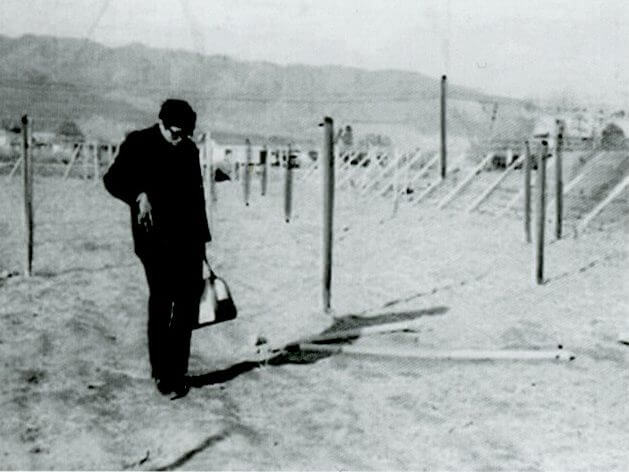
About a month after the Kofu Incident, Hiroshi Minamiyama, a Japanese writer and researcher of strange phenomena went with Masato and Katsuhiro to investigate the vineyard where the UFO was believed to have landed.
The vineyard was lined with concrete pillars, which were used to support the vines during the growing season. In addition, the wires were stretched in a mesh-like pattern through the top of each concrete pillar. According to Hiroshi Minamiyama’s research, the average height of those concrete pillars was about 170 centimeters (about 5.6 feet), and the spacing between the concrete pillars was just under 2.2 meters (about 7.2 feet).
Minamiyama also had Masato and Katsuhiro draw the approximate size of the UFO they had witnessed on the ground of the vineyard. Based on the size of the drawings on the ground, the diameter of the UFO was determined to be about 4.8 to just over 5 meters (about 15.7 to 16.4 feet).
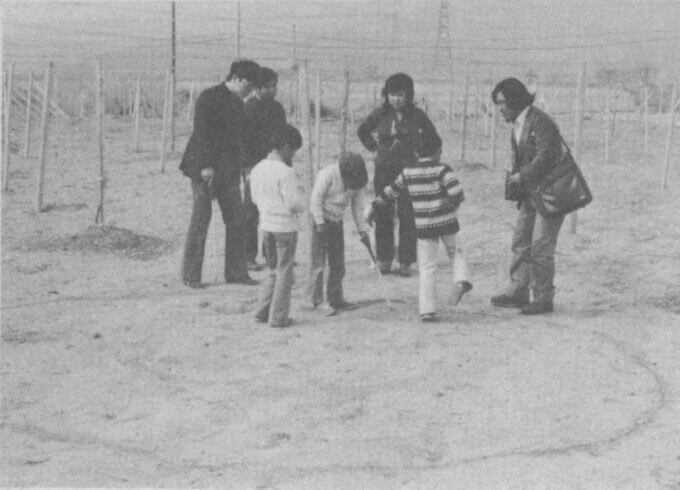
Comparing these figures, Minamiyama noticed that there were inevitably contradictory points.
Where did the UFO, which is about 5 meters in diameter, enter the vineyard and how did it land in the middle of the vineyard without knocking over the surrounding concrete pillars, which have a spacing of only about 2 meters?
Moreover, the broken pillar was in the center of the vineyard, and there was nothing wrong with the outer pillars.
Therefore, if the size of the UFO is as the boys claimed, it is physically impossible for the UFO to enter the vineyard without breaking the outside pillars.
Thus, there are major discrepancies in the boys’ accounts that are physically impossible.
What does this all mean?
Radiation Measurements at the UFO Landing Site
Susumu Maeda, a teacher in the electrical department of Kizan Technical High School (closed in March 1999) in Kofu City, Yamanashi Prefecture, holds a national certification as a radiation protection supervisor (Type 1), and together with students from the science research club of Kizan High School, measured the radioactivity at the UFO landing site.
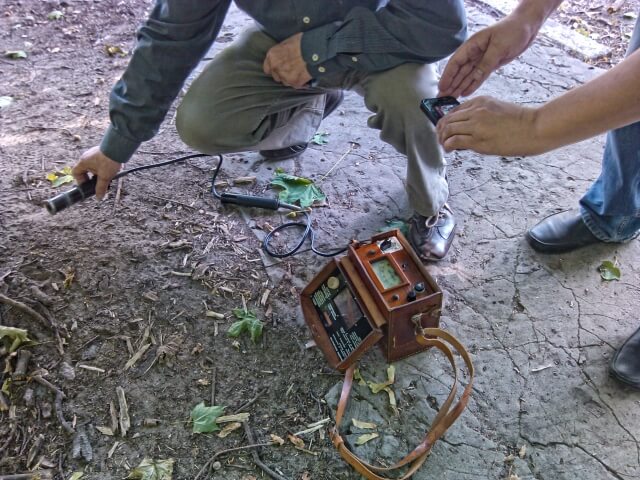
As a result, the first beta measurement detected weak beta radiation with a half-life of about 15 days, which Maeda said convinced him that this was not caused by nature but by an artificial source.
In this regard, Honjo had Maeda’s data verified by the prefectural government’s department measuring environmental radioactivity, with the cooperation of Gifu University professor emeritus Kazuo Tanaka (also known as the author of “The Mystery of Utsuro-bune” under the pen name Shoichi Kamon), who specialized in optical information engineering.
As a result, Honjo received several replies regarding the data, which, when summarized, led to the following conclusions.
The data of the measurement results varied widely, and it cannot be said that there is decay of radiation from these results alone.
The data of the measurement results are inconsistent and unclear, and no clear conclusion can be drawn from these data.
By the way, in 2020, Tsuneo Kira, a senior researcher of JSPS (Japan Space Phenomena Society), re-examined Maeda’s data and published the results on August 6, 2020, on web MU, the official website of the Japanese monthly occult magazine “MU”.
According to this article, Kira re-examined the data based on the M-report describing the experimental data left by Maeda.
As a result, Kira points out that the radiation source of Maeda’s data may be the radioactive isotope phosphorus-32, which has a half-life of 14.26 days and deduces the following.
The site of the Close Encounter of Third Kind in the Kofu Incident is a farm field. It is not surprising that a lot of phosphorus fertilizer has been spread on it. What if a nuclear reactor had appeared here?
All of the stories can be explained very well.
Now, let’s examine this.
Kira points out that the radioactive isotope phosphorus-32 was produced when the phosphorus sprinkled on the vineyard was exposed to radiation from the UFO’s reactor, but this is scientifically impossible.
Because phosphorus-32 can be generated synthetically by irradiation of sulfur-32 with moderately fast neutrons as shown in the following nuclear equation:
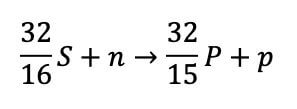
The above equation indicates that the nucleus of sulfur 32 captures a neutron and releases a proton, reducing its atomic number by one while maintaining its mass number of 32, resulting in the generation of phosphorus-32.
The table below shows my recalculated values based on the data from Sample A (No. 23) and Sample B (No. 7) of the M-report.
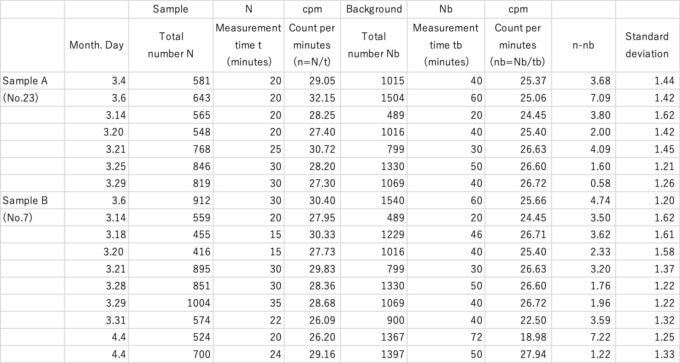
Note that, of the above data, 3.31 of Sample B and the first 4.4 data were excluded from Kira’s reanalysis because the M-Report commented that “Mica window 2.1 mg/cm2 was used (for these two data), all others were 1.5 mg/cm2“.
Based on the data above, I also reproduced Kira’s graph of n/nb ratios.
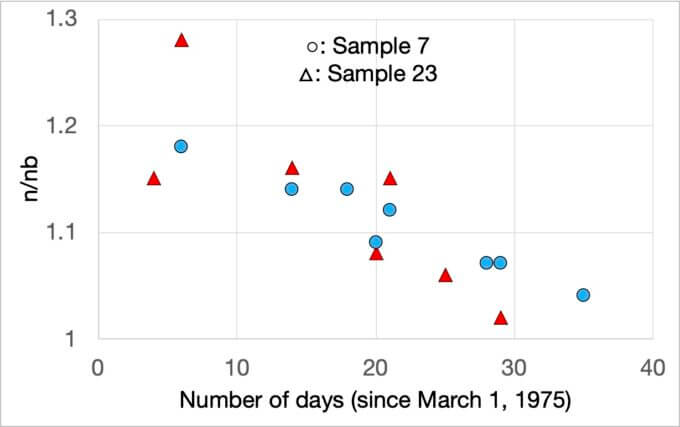
Commenting on this graph, Kira said,
The data from the two samples are beautifully mixed.
My analysis of the two samples combined is not incorrect.
The graph below shows the data for samples 7 and 23, excluding the effect of bag-ground radioactivity.
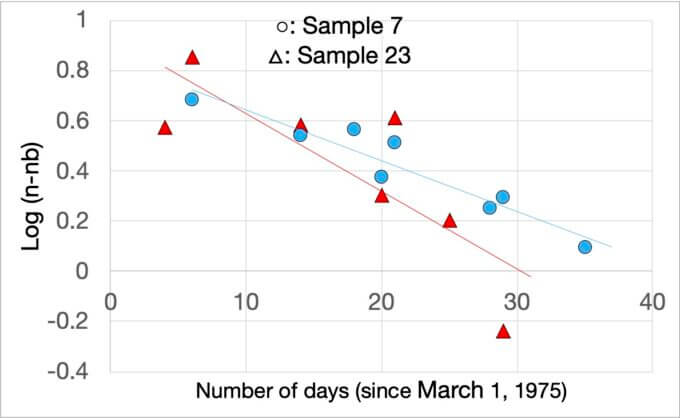
As the figure above shows, the data for Sample 7 (blue circles) seems to decay generally on a straight line, although there is some variation. On the other hand, the data for sample 23 (red triangles) seems to have too much variation to be approximated by a straight line.
Therefore, it does not seem to make physical sense to combine these two sets of data into one.
The graph below also shows the standard deviation of the data for samples 7 and 23.
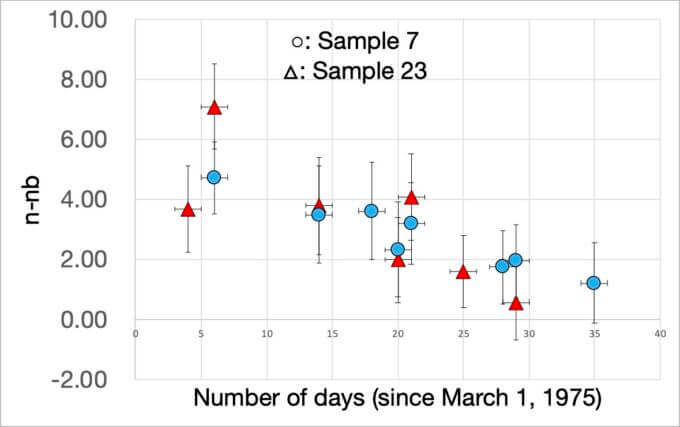
As is evident from the graph above, it seems impossible to accurately determine the half-life from this data, as the variation in the data is too great.
Thus, there is so much variation in the M-Report data that it seems impossible to draw any physically significant conclusions from these data.
Alien Sighting of Midori Sato, an Insurance Saleswoman
As another report, around the same time the UFO was sighted, Midori Sato, an insurance saleswoman, happened to be passing through the same area as the sighting site.
According to Sato, before evening, at around 5:30 p.m., she saw two children about 130 to 140 centimeters (about 4.5 feet) tall with dark skin on their faces and hands at a crossroads in the middle of a narrow street.
Sato was surprised by the bizarre appearance of the child she saw through the windshield. The child’s face and hands were so wrinkled and eerie that they seemed out of this world.
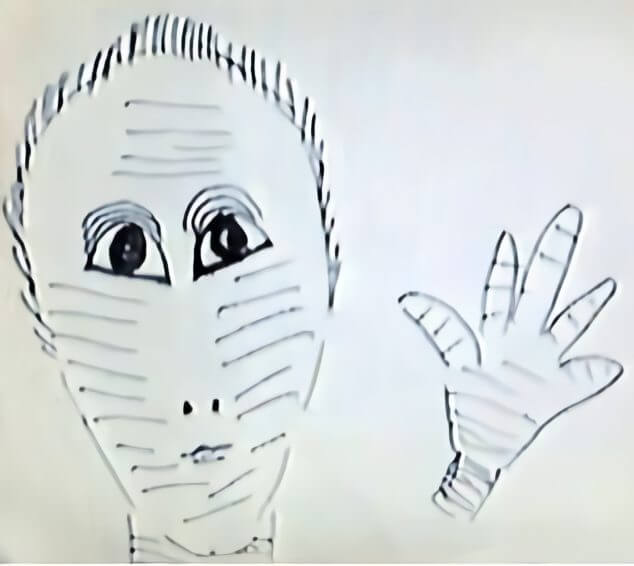
After that, she continued driving south down the road on the east side of Hinode Complex, when a group of men and women with children came running from the road ahead. They somehow had sticks in their hands and stopped Sato’s car with their arms outstretched.
Sato rolled down her car window and asked,
What’s going on?
One of them asked her,
Did you see a UFO?
Sato replied,
No, I don’t know.
And they ran past her car to the street behind her.
Regarding this Sato’s account of encountering a group of men and women with children and holding sticks in their hands, you may be wondering if they were Masato and Katsuhiro and their families.
However, Honjo of ASIOS denies this. This is because the time Sato claims to have met the group was around 5:30 to 6:00 p.m. when it was getting dark, while the actual time Masato and Katsuhiro’s family rushed to the vineyard was around 6:50 p.m. when it was pitch dark.
In addition, new information that denies Sato’s account was recently revealed by Masato’s niece (Masato’s brother’s daughter).
In 2021, on the Youtube channel “RINAMARU,” Masato’s niece introduced a story she heard from her grandmother (Masato’s mother).
According to her, Masato and Katsuhiro’s family had no recollection of meeting anyone who looked like Sato at the time of the incident, and when Masato’s family learned of Sato’s experience, they said,
She is telling a lot of lies!
Furthermore, according to Honjo, Sato’s alien drawings were first shown to the public around mid-December 1982, a week before Spielberg’s film “ET” premiered in Japan and became a hot topic throughout Japan.
Therefore, Honjo suggests that Sato’s alien illustration may have been influenced by the aliens in “ET”. In fact, UFO director Junichi Yaoi, who first interviewed Sato, also noted that her alien illustration resembles the aliens in “ET”.
It is also conceivable that neighborhood kids in costume might have been upset that Sato honked her horn at them, and might have simply played a prank by placing his hand on the windshield of her car.
Two UFOs Glowing Orange Observed at the Kamicho Housing Complex
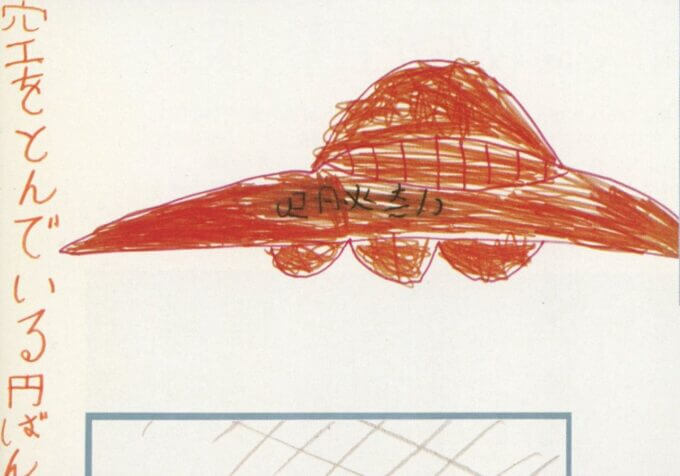
Honjo points out that sunset on February 23, 1975, was at 5:37 p.m., so it must have already been dark by the time the boys saw the orange UFO, just after 6:30 p.m., so the bright orange UFO flying over the site would surely have been noticed by the residents of the Kamicho housing complex from inside.
However, considering that no residents of the Kamicho housing complex specifically reported seeing the bright light that night, the boys’ sighting naturally loses credibility, he pointed out.
So let’s examine this point.
By the way, the sunset time of the UFO sighting site on the day of the incident can be scientifically calculated based on the Sunset equation.
The latitude and longitude of the Kofu City-owned kamicho housing complex, where the boys first saw the orange luminous objects, are 35.66228 (35° 39′ 44.208″) and 138.5682015 (138° 34′ 5.5272″), respectively.
According to NOAA (National Oceanic and Atmospheric Administration) Solar Calculator, the sunset time on the day of the incident (February 23, 1975) at this location was 5:34 PM.
The sunset time of 5:37 p.m. given by Honjo is not accurate, as it is based on the 138° E longitude line.
In addition, the Kofu Basin, where Kofu City is located, gets dark earlier than the above-mentioned sunset time because the evening sun is blocked by the 3000-meter-high Akaishi Mountains on the west side, as shown in the picture below.
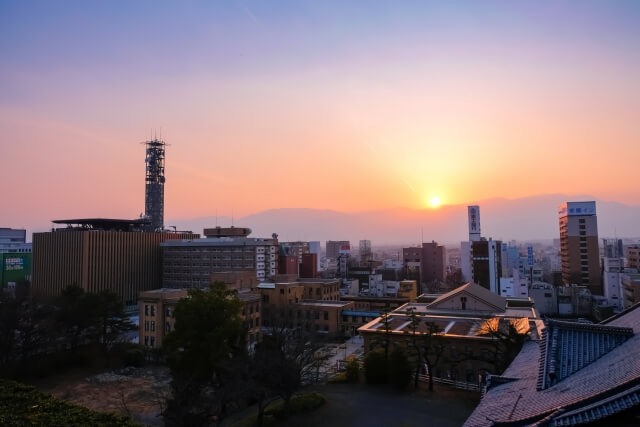
Therefore, it would seem likely that on the day of the incident, the sun would have been hidden behind the Akaishi Mountains at some point prior to 5:34 PM, the time of sunset.
In addition, according to data from Japan’s Meteorological Agency, the cloud cover in Kofu City on that day was 2 (20% cloud cover), the moon was 11.9, the direction of the moon at 18:00 was east, the altitude was 40°, and the temperature was 4.1°C (39.38°F).
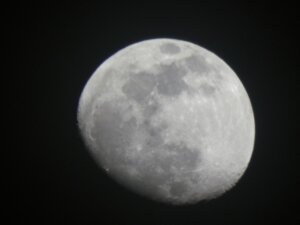
According to an article in the Yamanashi Nichinichi Shimbun, it was clear and cloudless in the Kofu area on the night of February 23, 1975.
But even if the sun is below the horizon, the sky does not darken immediately; a period of dim light (twilight) occurs for a while. This is because sunlight scattered in the upper atmosphere illuminates the lower atmosphere and the earth’s surface.
The following explanation is partly cited from Wikipedia’s description of Twilight.
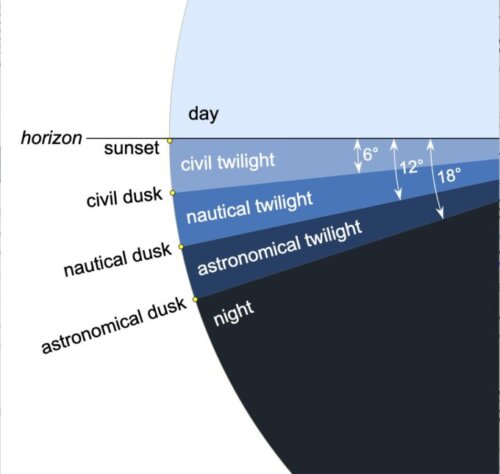
As shown in the figure above, three twilights are defined according to which angular range the geometric center of the sun is above the horizon: civil twilight, nautical twilight, and astronomical twilight.
Civil Twilight
Civil twilight is defined as when the geometric center of the Sun is between 6° below the horizon and the horizon itself.
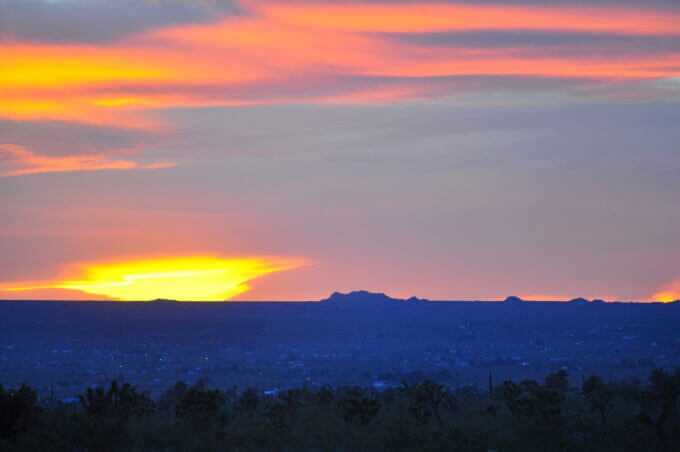
Source: Jessie Eastland – Own work
Civil twilight is the period when enough natural light remains that artificial light in towns and cities is not needed.
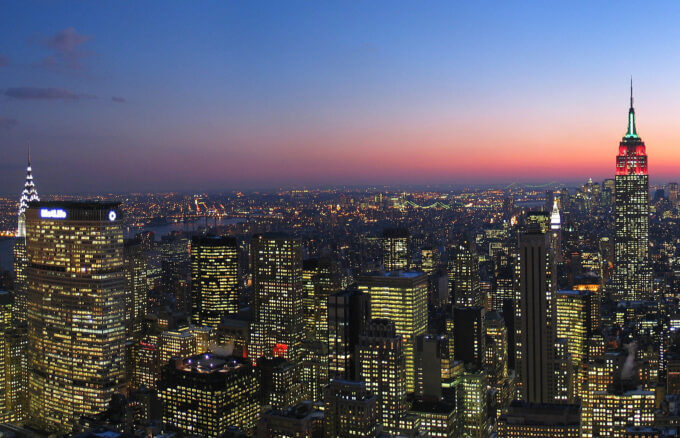
Source: Dschwen – English Wikipedia
According to the SUNRISE/SUNSET/TWILIGHT CALCULATOR, the civil twilight at the UFO sighting site (latitude: 35.66228, longitude: 138.5682015) on February 23, 1975, began at 5:34 PM and ended at 5:59:51 PM.
Nautical Twilight
Nautical twilight is defined as when the geometric center of the Sun is between 12° and 6° below the horizon.
Under good atmospheric conditions with the absence of other illumination, during nautical twilight, the human eye may distinguish general outlines of ground objects but cannot participate in detailed outdoor operations.
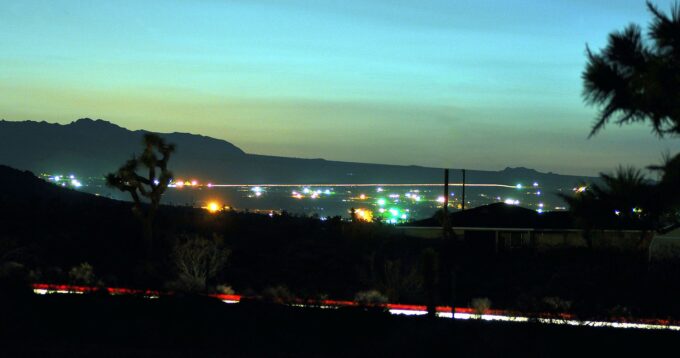
Source: Jessie Eastland – Own work
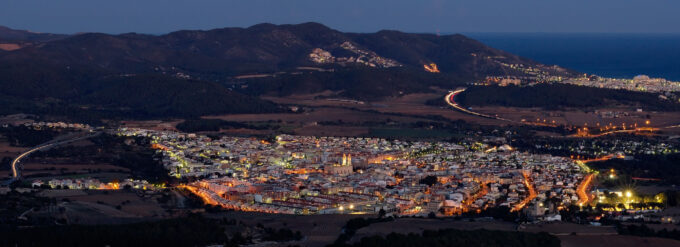
Source: Mick Stephenson mixpix – Own work
According to the SUNRISE/SUNSET/TWILIGHT CALCULATOR, the nautical twilight at the UFO sighting site on February 23, 1975, began at 5:59:51 PM and ended at 6:29:33 PM.
Astronomical Twilight
Astronomical twilight is defined as when the geometric center of the Sun is between 18° and 12° below the horizon.
During astronomical twilight, the sky is dark enough to permit astronomical observation of point sources of light such as stars, except in regions with more intense skyglow due to light pollution, moonlight, auroras, and other sources of light.
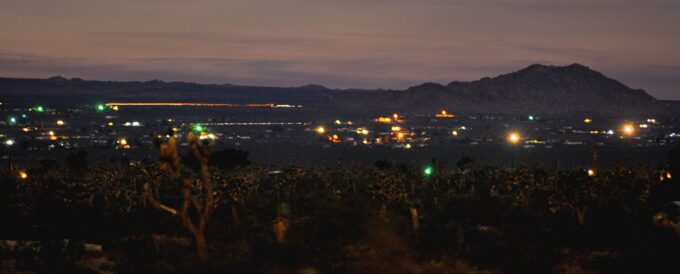
Source: Jessie Eastland – Own work
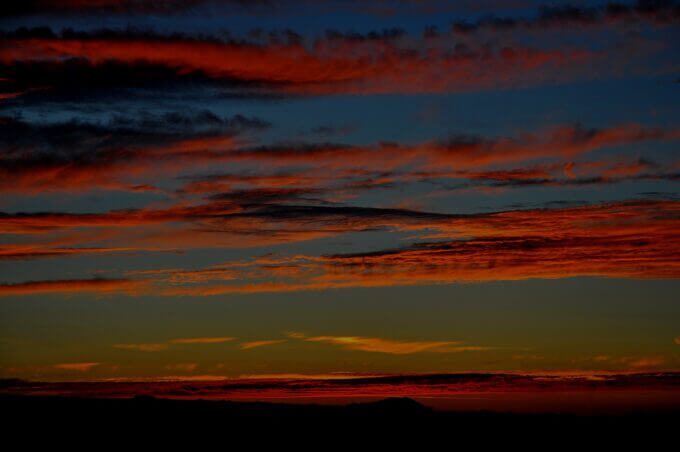
Source: Jessie Eastland – Own work
According to the SUNRISE/SUNSET/TWILIGHT CALCULATOR, the astronomical twilight at the UFO sighting site on February 23, 1975, began at 6:29:33 PM and ended at 6:59:07 PM.
By the way, the boys saw the orange UFO just after 6:30 p.m., which is the time when nautical twilight ends and astronomical twilight begins.
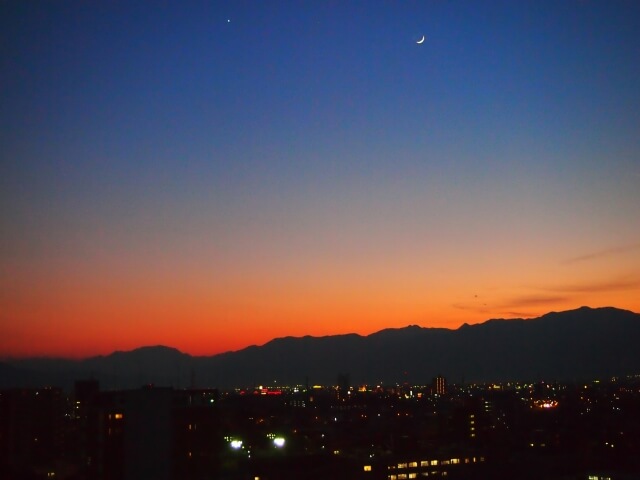
Therefore, as shown in the photo of Kofu City above, it is highly possible that the sky was not completely dark at this time, but there was still an orange evening sky.
Also, with orange skies and clouds, it would not be surprising if the residents of the Kamicho housing complex did not notice the orange UFO.
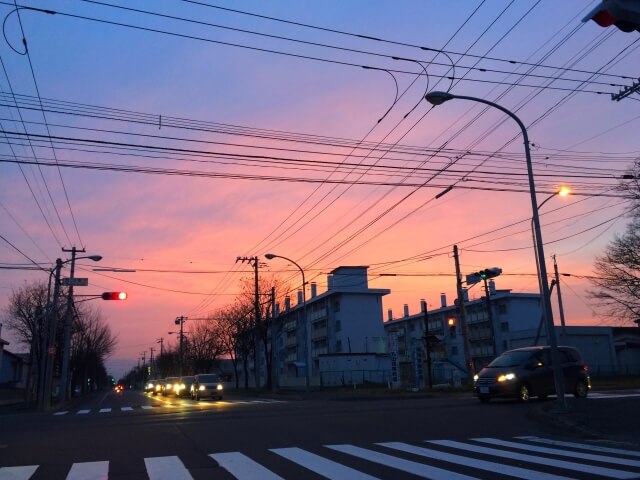
From the above considerations, there seems to be room for skepticism regarding Honjo’s reasoning that “it must have been already dark at the site” based solely on the sunset time.
Orange Luminous Object Sighted in the Vineyard

Regarding the orange luminous object sighted in the vineyard, Honjo points out that the witnesses may have misidentified it as a bonfire.
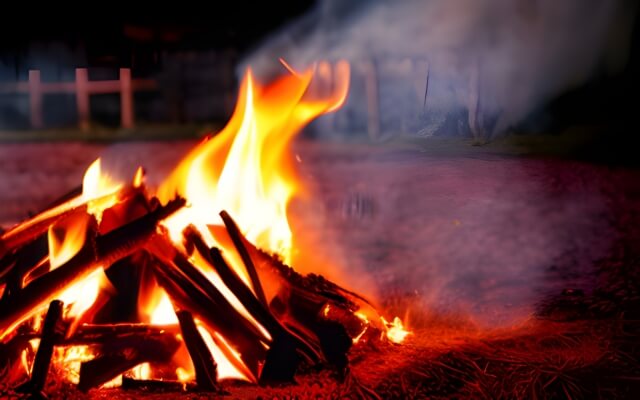
According to Honjo, 15 years after the Kofu Incident, the Kofu Incident was followed up on in a program called “Suteki ni Document” aired on Japan’s TV Asahi in January 1990, in which the vineyards at the site were shown and a bonfire was seen burning in the winter.
Another statement from a neighbor, Asahi and her daughter, who had visited the vineyard at the site the day after the incident, included the words,
There was something like ashes.
Let’s examine this.
Takashi Nohmi, Ph.D., Engineering, has been researching burnt smells and odors caused by fire for many years, focusing on the application of odor sensors, and in 2013 published his paper, “The Odor of Fire” (BUNSEKI KAGAKU Vol. 62, No. 4, pp. 285-296, 2013 The Japan Society for Analytical Chemistry).
According to the paper, the three sources of information that lead humans to fire detection are 1) flames and smoke detected by sight (54%), 2) burning odor detected by the sense of smell (16%), and 3) the sound of burning detected by the sense of hearing (14%).
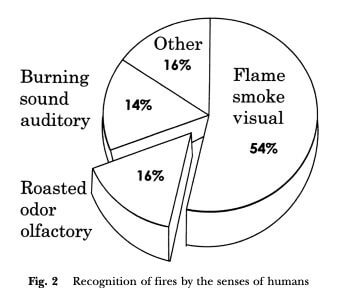
Dr. Nohmi explains that the ability to quickly detect the approach of fire and evacuate is a condition that prolongs life for all living things and that the human nose is very sensitive to the acrid smell and burning odor that comes from fire.
Therefore, if someone had made a bonfire in the vineyard where the UFO sighting took place, as Honjo points out, there would naturally have been a smell emitted from the smoke.
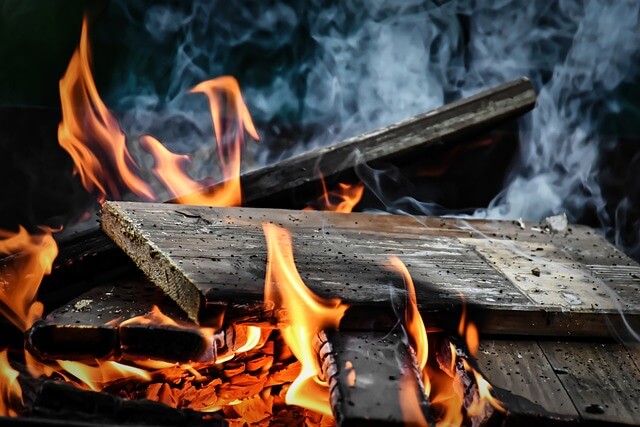
According to data from the Japan Meteorological Agency here, the wind direction in Kofu City on February 23, 1975, the day of the incident, was from the north-northwest (NNW) at 6:00 PM, with a wind speed of about 3.3 m/s (about 7.4 mph). The boys and their families then observed the orange luminous object for several minutes from a location just 50 meters (about 55 yards) south of the vineyard.

So naturally, they should have noticed the strange odor of smoke diffused by the wind and carried to the south.
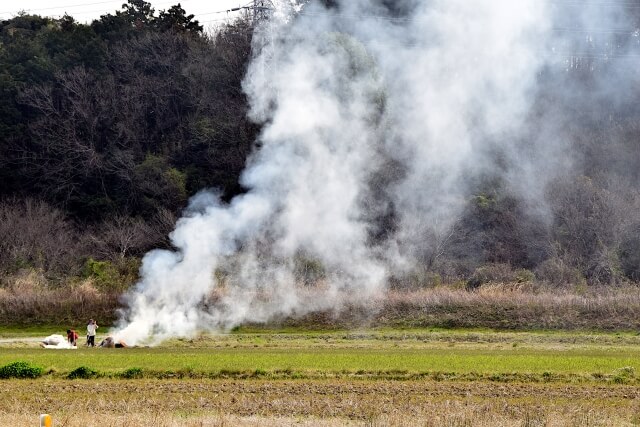
This is because even in the dark, the human nose is sensitive to the smell of bonfire smoke, as Dr. Nomi argues in his paper.
Therefore, the theory that the campfire was misidentified as an orange luminescent object seems unlikely, given the direction of the wind that night and the family’s location.
Influence of TV Programs
By the way, regarding the boys’ illustrations of aliens, it was pointed out that the boys may have been influenced by some creative works.
For example, it has been pointed out that the alien in the second season of the U.S. science fiction TV drama “The Outer Limits” (Japanese title: “Kuso Kagaku Eiga Ultra Zone (Fantasy Science Movie Ultra Zone)”) closely resembles the alien in the illustrations drawn by the boys.
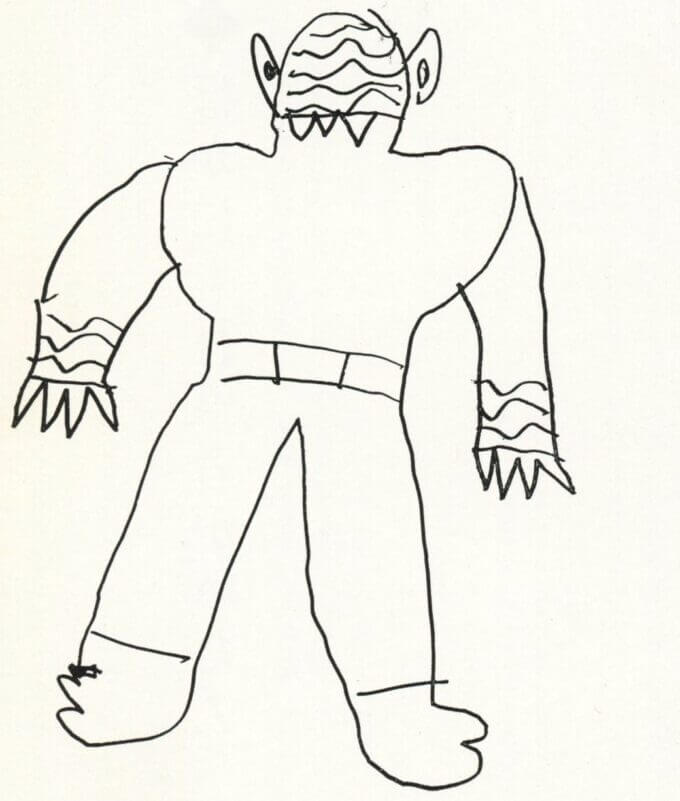
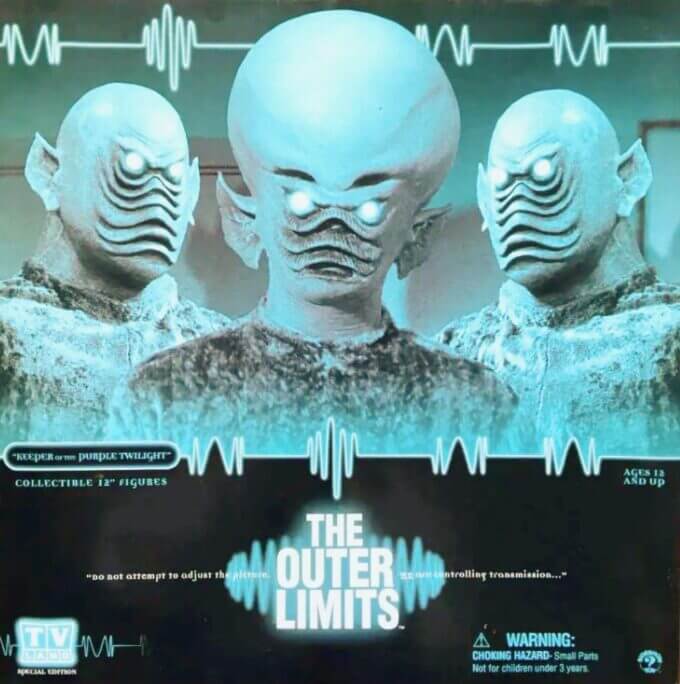
In Japan, “Outer Limits” was aired by NTV and NNN member stations (Yamanashi Broadcasting in Kofu City) in 1966; it is unlikely that boys born in 1968 watched this broadcast in real-time, so if they did see this drama on TV, it was most likely in a rerun.
Therefore, Honjo checked the TV column of the Yamanashi Nichinichi Shimbun for the past year from February 23, 1975, but he could not find any reruns of “The Outer Limits”.
Honjo pointed out that if the boys had been watching reruns of “The Outer Limits,” they might have been influenced.
Influence of Japanese Boys’ Manga Magazine
Honjo also thought that Japanese boys’ comic magazines might have influenced the boys, so he looked into “Shonen Magazine,” which ran regular UFO features in Japan at that time in the 1970s.
As a result, he found an illustration of an alien in the February 24, 1974 (No.9) issue of Shonen Magazine that looked relatively similar to the aliens the boys had drawn.
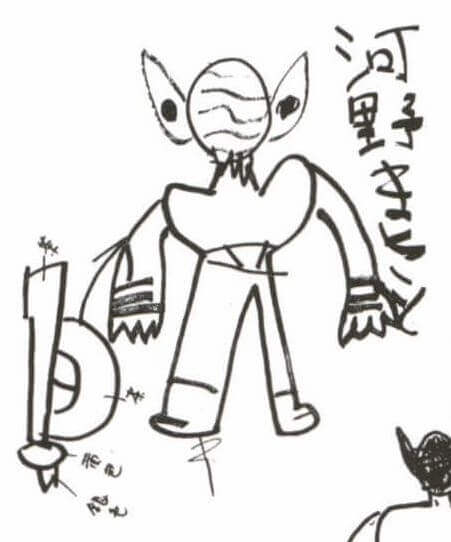
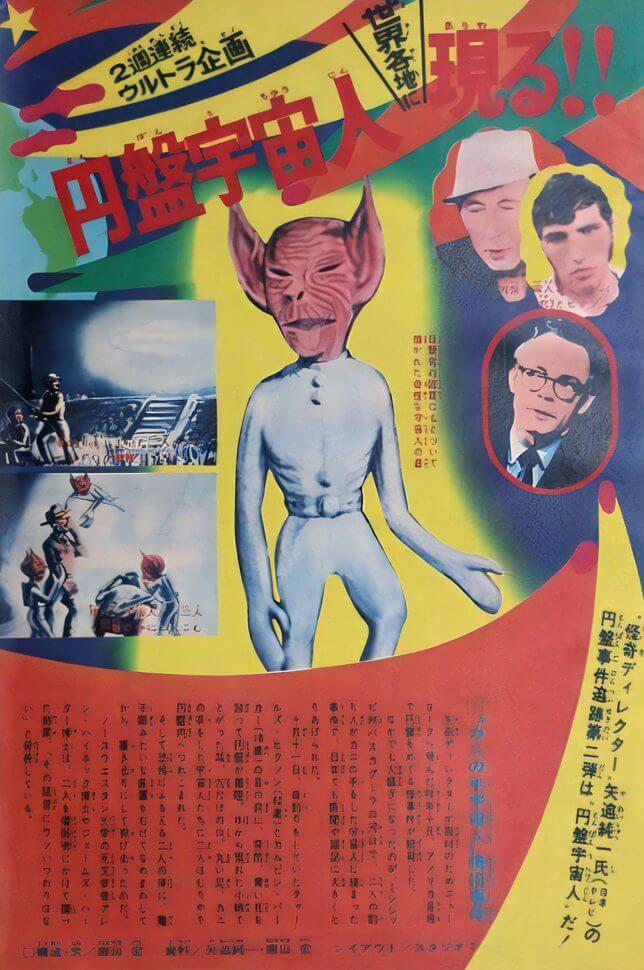
As can be seen by comparing the illustrations above, the alien in the Shonen Magazine illustration resembles the alien drawn by Masato in terms of its large pointy ears, brown face, horizontal wrinkles on the face, silver space suit, waist belt, and short stature.
On the other hand, the alien in the Shonen Magazine illustration differs from the aliens depicted by the boys in that its face has eyes, a nose, and a mouth; it does not have three fangs on its mouth; and it has five fingers.
The illustration of the alien appeared on the first page of the color feature at the beginning of the February 24, 1974 (No. 9) issue of Shonen Magazine, and thus was likely to have remained in the memories of children at the time. However, its release date was about a year before the Kofu Incident.
Honjo, therefore, points out that it is unlikely that the boys remembered the alien illustration they saw in Shonen Magazine even a year after its release, and that it is possible that the boys may have seen and remembered the alien illustration in Shonen Magazine that was left behind and not discarded after its release.
In this light, it may be explained that the boys’ partially vague memory of the alien illustration in Shonen Magazine may have caused the above-mentioned differences in the alien drawn by the boys.
What is the Truth of the Kofu Incident?
As mentioned above, there are many negative opinions about the Kofu Incident, but none of them have conclusive evidence, and the truth of the matter remains shrouded in a veil.
Did the boys really encounter aliens?
You are the one who will find out the truth about the Kofu Incident!
So, for the benefit of armchair UFO detectives around the world, I have tried to present in this blog as much detail as possible the latest information as it is known at this time.
I hope you will use this information to get to the bottom of what really happened to the boys.
Published on March 15, 2023
Updated on March 20, 2023
Written by OTAKUPAPA
References
1. Tsutomu Seki (May 1973). Kera-murani Ochita Enban (The Flying Saucer That Fell on Kera Village),Michi no Hoshi wo Motomete (Searching for Unknown Stars), 187-194, Sankei Shobo.
2. Shinichiro Namiki, Kazuo Hayashi (Field Investigator) (April 1973).– JSPS Special Report –Soratobu Enban Ikedori Misui!! Kochishi Keramura de Okotta Kisou Tengaina Enban Soudou …… ??? (Attempted Live Capture of Flying Saucer! A Bizarre Flying Saucer Incident in Kera Village, Kochi City …… ???) Unidentified Flying Objects – Information and Research – Vol.1, No. 1, 48-50, Japan Space Phenomena Society (JSPS).
3. Mokuyou Special Gendai no Kaiki Tuikyu Daisandan Utyujinwa Tikyuni Kite Iru!! (Thursday Special: Modern Weirdness, Pursuit #3: Aliens are Coming to Earth!!), Nippon Television Network Corporation, broadcast on October 10, 1974.
4. Shusaku Endo (1976). Kera-cho no Soratobu Enban (Flying Saucer in Kera Town), Boku ha Koukishin no Katamari (I Am a Curious Man), 36-44, Shinchosha.
5. Junichi Yaoi (July 1978). Zenkoku UFO Mokugeki Tahatsu Chitai (UFO Sighting Zones in Japan), 272-277. FutamiShobo
6. Shinichiro Namiki, Tanbo de Chugakuseiga Kogata Enban wo Hokaku Nazo no ‘Kera UFO Jikenno Ima wo Ou!!(Junior High School Students Captured a Small Flying Saucer in Rice Fields: Now Tracing the Mysterious ‘Kera UFO Incident!!’), MU Magazine, April 2014 issue, 172-177, Gakken.
7. Hiroshi Yamamoto, Kazuo Shimizu, and Ryutaro Minakami (July 2005). Tondemo UFO Nyumon (Introduction to Ridiculous UFO Cases and Researchers), Yosensha.
8. Junichi Yaoi (June 2006). Yaoi Junichi no UFO Taizen (Junichi Yaoi’s Complete UFO Collection), 254-256, Lyonsha.
9. Kenichi Nishimoto (May 2009). Kochi-ken Kera-cho “UFO Hokaku Jiken” no Shogeki (The Impact of the “UFO Capture Incident” in Kera Town, Kochi Prefecture), Nihon “Kaiki” Taizen (The Complete Book of Japanese “Weirdness”), 239-253, Million Shuppan
10. Shinichiro Namiki (Feburary 2010). Mikakunin Hikou Buttai UFO Taizen (The Complete Guide to Unidentified Flying Objects UFOs), 227-233, Gakken Plus.
11. Miyabi (November 8, 2015), Kera Incident, UFO Jikenbo (UFO Case Files), http://ufojikenbo.blogspot.com/2015/11/kera.html
12. Kenji Sato, Radio Adventure, Kikai Isan (Odd World Heritage), NHK Radio 1, broadcast on May 3, 2016.
13. MYSTERY PHOTONICLE (May 2016), 40-41, Digital Ultra Project.
14. Tatsuya Honjo, ASIOS (August 2017). UFO Jiken Chronicle (Chronicle of UFO Incidents), 138-145, Saizusha.
15. Kozo Niwa, Kazuo Hayashi (June 2016). Nihon no Juyo UFO Jiken: Kochi Keramura UFO Hokaku Jiken (Important UFO Incident in Japan: Kochi Kera Village UFO Capture Incident), https://ameblo.jp/entry-12168532537.html
16. Ryoma Mulder (November 2002). Kochi Kogata UFO Hokaku Jiken Tenmatsu Report by Ryoma Mulder (Report on Capture of a Small UFO in Kochi by Ryoma Mulder), http://www.youneeds.com/xfiles/ufo/kela_ufo_catcher.htm
17. Yamanashi Nichinichi Shimbun dated February 25, 1975.
18. Kouku Denki Nyuumon (Introduction to Avionics) (March 2013) Japan Aviation Technology Association.
19. RINAMARU (February 2021) Dai Ikkai “Koufu Jiken no Kankeisha!? Rinamaru Toujou no Maki [Kyuru Kyuru Radio]” (Episode 1: A person related to the Kofu Incident! Rinamaru’s Debut [Kyurkyur Radio]), https://www.youtube.com/watch?v=YhxpX73kjOY&t=1234s
20. Tsuneo Kira (August 2020) 1975 nen “Koufu Jiken” Genba ni Nokosareta Houshasei Bussitu to “UFO no Genshiro” no Nazo (The Mystery of the Radioactive Material Left at the Site of the 1975 Kofu Incident and the “UFO Reactor”). MU web, https://web-mu.jp/paranormal/10437/
21. Nippon Meteorological Society’s database of bolides, http://www5e.biglobe.ne.jp/~shibaya/NMS/database.htm
22. “Twilight” Wikimedia Foundation. Last modified 5 March 2023, https://en.wikipedia.org/wiki/Twilight
23. NOAA (National Oceanic and Atmospheric Administration) Solar Calculator, https://gml.noaa.gov/grad/solcalc/
24. SUNRISE/SUNSET/TWILIGHT CALCULATOR, http://users.softlab.ntua.gr/~ipanag/fromnetmode/scripts/suntime.htm
25. Japan Meteorological Agency, https://www.jma.go.jp/jma/index.html
26. Takashi Nohmi, “The Odor of Fire” (BUNSEKI KAGAKU Vol. 62, No. 4, pp. 285-296, 2013 The Japan Society for Analytical Chemistry), https://www.jstage.jst.go.jp/article/bunsekikagaku/62/4/62_285/_article/-char/en
27. “Keeper of the Purple Twilight,” which aired on December 5, 1964, in the second series of “The Outer Limits.”
28. Shonen Magazine, February 24, 1974 (No.9) issue, Kodansha Ltd.

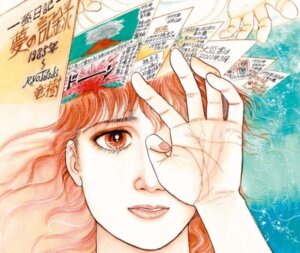
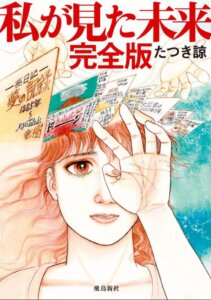
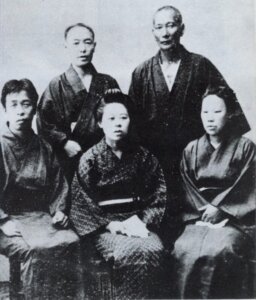
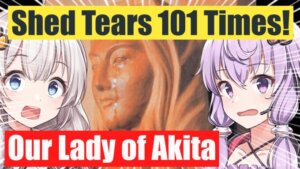
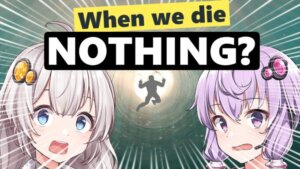
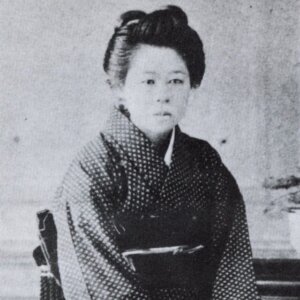
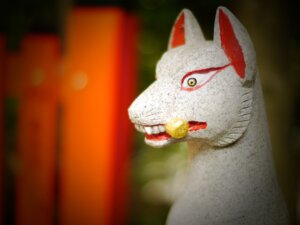
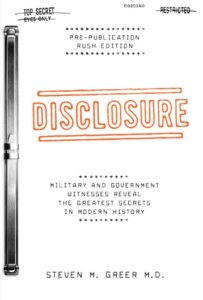
Comments